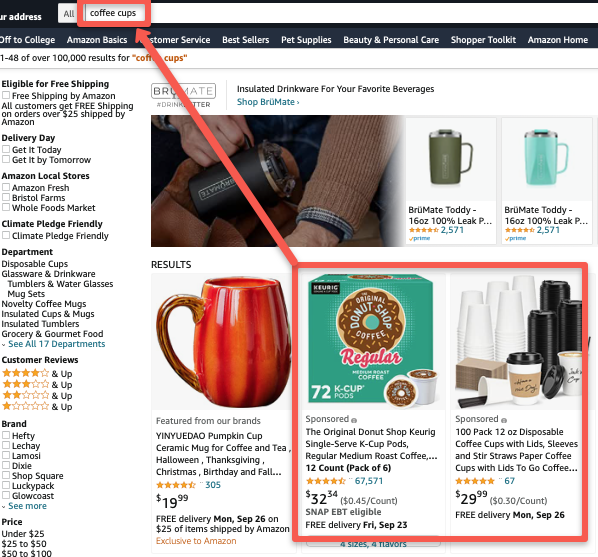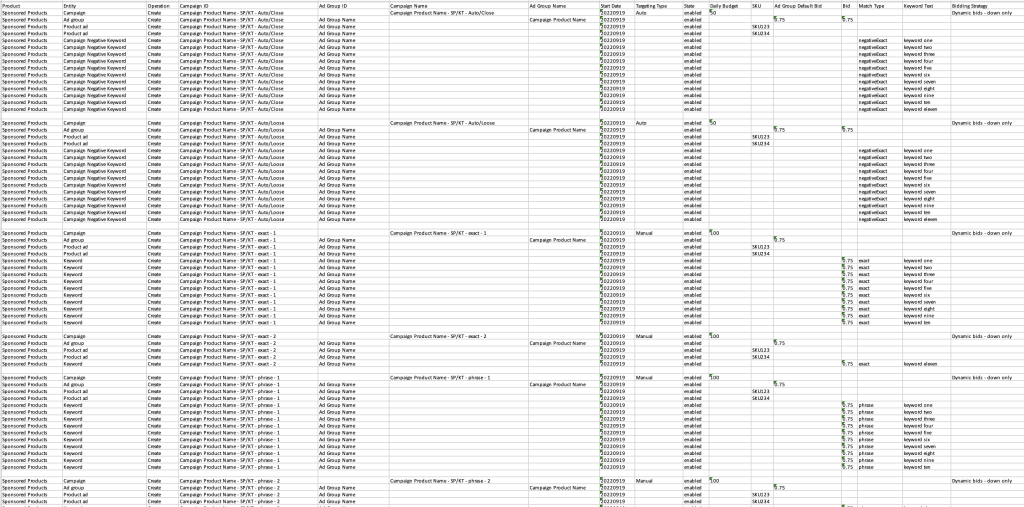The goal of the article is to introduce using bulksheets when creating new sponsored product campaigns specifically for keyword targeting. Although we briefly talk about what some key terms are when creating campaigns, there are many more in-depth tutorials on YouTube, Amazon’s website, and hundreds of other sites that talk about setting up and optimizing your PPC campaigns.
Future articles will discuss creating campaigns for sponsored product campaigns for product targeting. The article will also mention the differences between the two.
Don’t miss new articles or updates! Sign up for our newsletter.
- Sponsored Products for Keyword Targeting
- Spreadsheet Columns For Creating Sponsored Product Keyword Targeting Campaigns
- Creating Exact, Phrase, Broad, and Auto Campaigns
- Overview of Match Types: Exact, Phrase, and Broad
- Auto Loose Versus Auto Close Campaigns
- Limiting Keywords For Campaigns
- Close to 100 Rows Created for Just 11 Keywords!
Sponsored Products for Keyword Targeting

Sponsored products for keyword targeting are used when you want the customer to see your ad by searching specific key terms in Amazon’s search engine. The ads could show up when users enter terms that are used in your Exact, Phrase, or Broad campaigns (more on that later).
If you are using Auto campaigns, you do not need to use any keywords as Amazon will use the information on your listing to determine what keywords will trigger your ad to show up.
When using bulksheets, you can create all your campaigns, including Auto campaigns and add negative keywords to your campaigns by uploading a single bulk spreadsheet.
Spreadsheet Columns For Creating Sponsored Product Keyword Targeting Campaigns
17 columns are required to create keyword targeting campaigns for sponsored products (18 if you include the Portfolio ID):
- Product (Sponsored Products)
- Entity (Campaign, Ad Group, Product ad, Keyword, Campaign Negative Keyword)
- Operation (Create)
- Campaign ID (Campaign name)
- Ad Group ID (Ad group name)
- Portfolio ID (Optional)
- Campaign Name (Campaign name)
- Ad Group Name (Ad group name)
- Start Date (yyyymmdd)
- Targeting Type (Auto, Manual)
- State (Enabled, Disabled)
- Daily Budget
- SKU
- Ad Group Default Bid
- Bid
- Match Type (exact, phrase, broad, negativeExact)
- Keyword Text
- Bidding Strategy (Dynamic bids – down only, Dynamic bids – up and down, Fixed Bids)
You can add a “Portfolio ID” if you would like to include these campaigns in a specific portfolio. For Amazon’s official document for creating Sponsored Products campaigns, click here.
For access to all our sample templates, sign up for our newsletter here.
Creating Exact, Phrase, Broad, and Auto Campaigns

When creating new campaigns specifically for keyword targeting, we will create Exact, Phrase, Broad, and two auto campaigns. The two auto campaigns we create are Auto/Loose and Auto/Close.
For simplicity, we use the same keywords for Exact, Phrase, and Broad because phrase and broad often generate different keywords even with the same terms. We also add all the terms as Negative Exact terms in our Auto Campaigns.
As you can see, creating new campaigns involves multiple steps that can take a long time if you aren’t utilizing Amazon’s Bulk Operations.
Overview of Match Types: Exact, Phrase, and Broad
Manual Targeting requires you to set the match type of Exact, Phrase, or Broad for each key term you enter. These match types are used to determine if the keywords the customer used to search will cause your ad to display. Here’s what it means:
Let’s use “garlic press” as the key term
- Exact – must be an exact match. Only the search term “garlic press” would display the ad.
- Phrase – a key term in a specific sequence would show the ad.
- Ad will show: “black garlic press”, “garlic press for kitchen”
- Ad will not show: “garlic strip press”, “best press garlic”
- Broad – keywords in any sequence would show the ad.
- Ad will show: “best press for garlic”, “the garlic device to press for kitchen”
- Ad will not show: “garlic skinner”, “best spice press for home”
Auto Loose Versus Auto Close Campaigns

Auto Targeting will automatically display your ad to users who search specific terms using Amazon’s search engine. What they display will depend on the keywords, categories, and other information used on your product’s listing.
We create 2 auto campaigns for each campaign. One using “Loose match” and one using “Close match”.
- Loose Match – When this is set, search terms that are “loosely” related to your product will show up.
- example: you sell coffee cups, so terms containing mugs or espresso may show up
- Close Match – When this is set, search terms that are closely related to your product will show up.
- example: you sell a set of glass bottles for juicing. Terms like “glass bottles for milk” or “glass bottle sets for kitchen” may show up
In previous versions of bulksheets, you could set these values in the spreadsheet. In the latest version, this is not possible. You have to manually select these values in the Campaign Manager after creating the campaign.

Limiting Keywords For Campaigns

We limit our keywords to 10 per campaign. This is to increase the chances that the keywords will get impressions. For some reason, having 10 campaigns with 10 keywords seems to have a better chance of getting impressions for more of the keywords than having 1 campaign with 100 keywords.
Some sellers we know even use a maximum of 5 keywords per campaign or let the campaign run for a while before moving the keywords with zero impressions to new campaigns.
Close to 100 Rows Created for Just 11 Keywords!

Sign up for our newsletter to access our template library
If we were to create 11 new keywords for new keyword targeting campaigns, the bulk spreadsheet would be a little under 100 rows. The spreadsheet above also uses 2 SKUs as an example.
This includes the Auto Close/Loose campaigns and the Exact, Phrase, and Broad campaigns. We also add these keywords as “negatives” in the Auto campaigns.
To access a sample template of our bulksheets when creating a new campaign with 11 keywords, sign up for our newsletter here.
